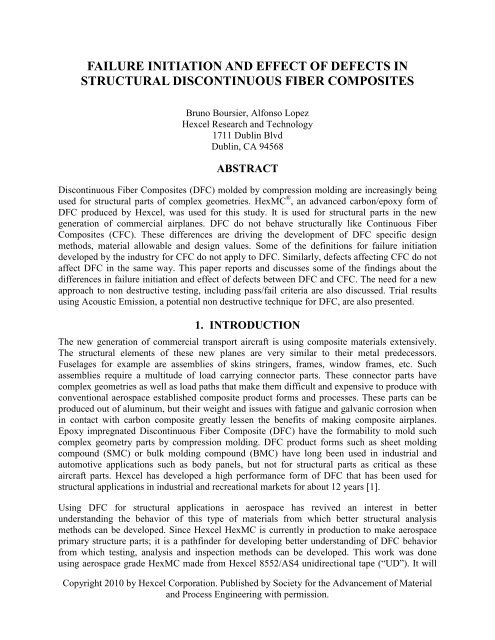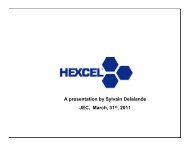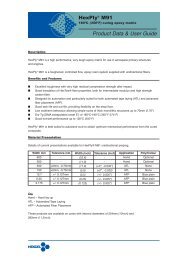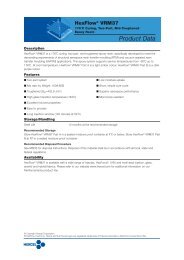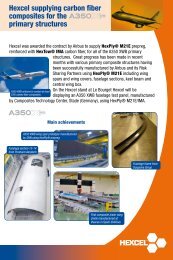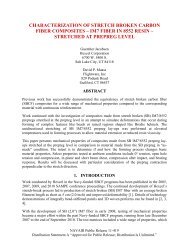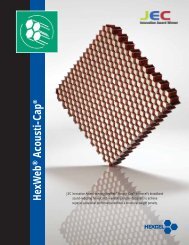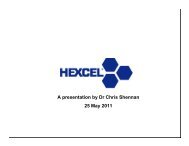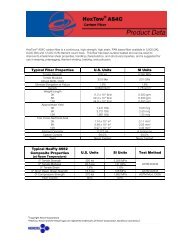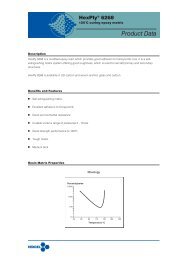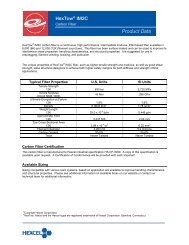failure initiation and effect of defects in structural ... - Hexcel.com
failure initiation and effect of defects in structural ... - Hexcel.com
failure initiation and effect of defects in structural ... - Hexcel.com
Create successful ePaper yourself
Turn your PDF publications into a flip-book with our unique Google optimized e-Paper software.
FAILURE INITIATION AND EFFECT OF DEFECTS IN<br />
STRUCTURAL DISCONTINUOUS FIBER COMPOSITES<br />
Bruno Boursier, Alfonso Lopez<br />
<strong>Hexcel</strong> Research <strong>and</strong> Technology<br />
1711 Dubl<strong>in</strong> Blvd<br />
Dubl<strong>in</strong>, CA 94568<br />
ABSTRACT<br />
Discont<strong>in</strong>uous Fiber Composites (DFC) molded by <strong>com</strong>pression mold<strong>in</strong>g are <strong>in</strong>creas<strong>in</strong>gly be<strong>in</strong>g<br />
used for <strong>structural</strong> parts <strong>of</strong> <strong>com</strong>plex geometries. HexMC ® , an advanced carbon/epoxy form <strong>of</strong><br />
DFC produced by <strong>Hexcel</strong>, was used for this study. It is used for <strong>structural</strong> parts <strong>in</strong> the new<br />
generation <strong>of</strong> <strong>com</strong>mercial airplanes. DFC do not behave <strong>structural</strong>ly like Cont<strong>in</strong>uous Fiber<br />
Composites (CFC). These differences are driv<strong>in</strong>g the development <strong>of</strong> DFC specific design<br />
methods, material allowable <strong>and</strong> design values. Some <strong>of</strong> the def<strong>in</strong>itions for <strong>failure</strong> <strong><strong>in</strong>itiation</strong><br />
developed by the <strong>in</strong>dustry for CFC do not apply to DFC. Similarly, <strong>defects</strong> affect<strong>in</strong>g CFC do not<br />
affect DFC <strong>in</strong> the same way. This paper reports <strong>and</strong> discusses some <strong>of</strong> the f<strong>in</strong>d<strong>in</strong>gs about the<br />
differences <strong>in</strong> <strong>failure</strong> <strong><strong>in</strong>itiation</strong> <strong>and</strong> <strong>effect</strong> <strong>of</strong> <strong>defects</strong> between DFC <strong>and</strong> CFC. The need for a new<br />
approach to non destructive test<strong>in</strong>g, <strong>in</strong>clud<strong>in</strong>g pass/fail criteria are also discussed. Trial results<br />
us<strong>in</strong>g Acoustic Emission, a potential non destructive technique for DFC, are also presented.<br />
1. INTRODUCTION<br />
The new generation <strong>of</strong> <strong>com</strong>mercial transport aircraft is us<strong>in</strong>g <strong>com</strong>posite materials extensively.<br />
The <strong>structural</strong> elements <strong>of</strong> these new planes are very similar to their metal predecessors.<br />
Fuselages for example are assemblies <strong>of</strong> sk<strong>in</strong>s str<strong>in</strong>gers, frames, w<strong>in</strong>dow frames, etc. Such<br />
assemblies require a multitude <strong>of</strong> load carry<strong>in</strong>g connector parts. These connector parts have<br />
<strong>com</strong>plex geometries as well as load paths that make them difficult <strong>and</strong> expensive to produce with<br />
conventional aerospace established <strong>com</strong>posite product forms <strong>and</strong> processes. These parts can be<br />
produced out <strong>of</strong> alum<strong>in</strong>um, but their weight <strong>and</strong> issues with fatigue <strong>and</strong> galvanic corrosion when<br />
<strong>in</strong> contact with carbon <strong>com</strong>posite greatly lessen the benefits <strong>of</strong> mak<strong>in</strong>g <strong>com</strong>posite airplanes.<br />
Epoxy impregnated Discont<strong>in</strong>uous Fiber Composite (DFC) have the formability to mold such<br />
<strong>com</strong>plex geometry parts by <strong>com</strong>pression mold<strong>in</strong>g. DFC product forms such as sheet mold<strong>in</strong>g<br />
<strong>com</strong>pound (SMC) or bulk mold<strong>in</strong>g <strong>com</strong>pound (BMC) have long been used <strong>in</strong> <strong>in</strong>dustrial <strong>and</strong><br />
automotive applications such as body panels, but not for <strong>structural</strong> parts as critical as these<br />
aircraft parts. <strong>Hexcel</strong> has developed a high performance form <strong>of</strong> DFC that has been used for<br />
<strong>structural</strong> applications <strong>in</strong> <strong>in</strong>dustrial <strong>and</strong> recreational markets for about 12 years [1].<br />
Us<strong>in</strong>g DFC for <strong>structural</strong> applications <strong>in</strong> aerospace has revived an <strong>in</strong>terest <strong>in</strong> better<br />
underst<strong>and</strong><strong>in</strong>g the behavior <strong>of</strong> this type <strong>of</strong> materials from which better <strong>structural</strong> analysis<br />
methods can be developed. S<strong>in</strong>ce <strong>Hexcel</strong> HexMC is currently <strong>in</strong> production to make aerospace<br />
primary structure parts; it is a pathf<strong>in</strong>der for develop<strong>in</strong>g better underst<strong>and</strong><strong>in</strong>g <strong>of</strong> DFC behavior<br />
from which test<strong>in</strong>g, analysis <strong>and</strong> <strong>in</strong>spection methods can be developed. This work was done<br />
us<strong>in</strong>g aerospace grade HexMC made from <strong>Hexcel</strong> 8552/AS4 unidirectional tape (“UD”). It will<br />
Copyright 2010 by <strong>Hexcel</strong> Corporation. Published by Society for the Advancement <strong>of</strong> Material<br />
<strong>and</strong> Process Eng<strong>in</strong>eer<strong>in</strong>g with permission.
<strong>of</strong>ten be referred as “DFC” <strong>in</strong> this paper as most <strong>of</strong> the f<strong>in</strong>d<strong>in</strong>gs (<strong>in</strong> trend) are valid for DFC <strong>in</strong><br />
general.<br />
1.1 DFC Properties Overview<br />
For high performance DFC, special attention is taken to produce a high level <strong>of</strong> orientation<br />
r<strong>and</strong>omness <strong>of</strong> the short fibers, <strong>and</strong> to also ma<strong>in</strong>ta<strong>in</strong> straight fibers . High performance DFC like<br />
HexMC also have high fiber volume (>50%) <strong>and</strong> fiber length greater than 25 mm. This<br />
guaranties fiber to fiber load paths. As a result, moduli <strong>of</strong> such high performance DFC are<br />
similar to a quasi-isotropic (QI) lay-up made from the same fiber <strong>and</strong> res<strong>in</strong> constituents, see<br />
Figure 1.<br />
Part <strong>of</strong> the difference between DFC <strong>and</strong> QI lam<strong>in</strong>ates <strong>com</strong>es from the fact that DFC do not<br />
concentrate on the 0,+/-45, 90 directions as are QI lay-ups.<br />
Figure 1. Comparison <strong>of</strong> tension, <strong>com</strong>pression <strong>and</strong> flexure moduli <strong>of</strong> DFC (HexMC) <strong>and</strong> quasi<br />
isotropic lam<strong>in</strong>ate made from the same prepreg batch.<br />
As a result, the coupon stiffness can be predicted fairly accurately by us<strong>in</strong>g properties from QI<br />
lay-up with the same fiber, res<strong>in</strong> <strong>and</strong> fiber volume as high performance DFC. If care is taken to<br />
ma<strong>in</strong>ta<strong>in</strong> r<strong>and</strong>omness <strong>of</strong> the DFC dur<strong>in</strong>g the high pressure <strong>com</strong>pression mold<strong>in</strong>g <strong>of</strong> parts then<br />
part stiffness can be estimated us<strong>in</strong>g QI properties. However, strengths <strong>of</strong> DFC do not follow the<br />
strengths <strong>of</strong> QI lam<strong>in</strong>ate, as shown <strong>in</strong> Figure 2.
Figure 2. Comparison <strong>of</strong> tension, <strong>com</strong>pression <strong>and</strong> flexure strength <strong>of</strong> DFC (HexMC) <strong>and</strong> quasi<br />
isotropic lam<strong>in</strong>ate made from the same prepreg batch<br />
This difference <strong>in</strong> strengths between DFC <strong>and</strong> CFC is typical. The exact <strong>failure</strong> mechanism <strong>of</strong><br />
DFC is more <strong>com</strong>plex than for CFC, <strong>and</strong> there are no (<strong>in</strong>dustry accepted) <strong>failure</strong> criteria nor<br />
analysis methods to accurately predict ultimate strength <strong>of</strong> DFC parts. Work is on-go<strong>in</strong>g toward<br />
that goal at <strong>Hexcel</strong> as well as through an Advanced Materials for Transport Aircraft Structures).<br />
AMTAS is one <strong>of</strong> two university groups that together form the Jo<strong>in</strong>t Advanced Materials &<br />
Structures (JAMS) Center <strong>of</strong> Excellence. JAMS is supported by the FAA <strong>and</strong> several <strong>in</strong>dustrial<br />
partners [2].<br />
1.2 Insensitivity to Holes <strong>and</strong> Defects<br />
It was also found that DFCs are relatively non affected by notches/ holes especially when<br />
<strong>com</strong>pared with CFC, see Figure 3.<br />
Figure 3. Compression strengths for un-notched <strong>and</strong> notched coupons <strong>and</strong> Compression after<br />
Impact (CAI) <strong>of</strong> DFC (HexMC) <strong>and</strong> quasi isotropic lam<strong>in</strong>ate (QI) made from the same prepreg<br />
batch. Coupons were 30.5cm long x 3.8cm wide, the hole was 6.35 mm diameter.<br />
In addition to <strong>in</strong>sensitivity <strong>of</strong> holes, HexMC was also found to be <strong>in</strong>sensitive to <strong>defects</strong> dur<strong>in</strong>g<br />
qualification <strong>and</strong> certification test<strong>in</strong>g <strong>of</strong> over 1400 parts. Parts were tested <strong>in</strong> prist<strong>in</strong>e conditions<br />
(no <strong>defects</strong> determ<strong>in</strong>ed by ultrasonic test<strong>in</strong>g), as well as with three types <strong>of</strong> <strong>defects</strong>:
1. Molded-<strong>in</strong> <strong>defects</strong> (1.27 cm x 1.27 cm brass covered with Teflon ) imbedded between<br />
HexMC plies<br />
2. Visible damage from impact<br />
3. Incidental damage: cuts made with a saw <strong>and</strong>/or visible surface damages<br />
These <strong>defects</strong> were located <strong>in</strong> high stress areas <strong>of</strong> the parts as determ<strong>in</strong>ed by <strong>structural</strong> analysis<br />
<strong>and</strong> verified by test<strong>in</strong>g <strong>of</strong> the prist<strong>in</strong>e parts. Parts always had a <strong>com</strong>b<strong>in</strong>ation <strong>of</strong> <strong>defects</strong> <strong>and</strong><br />
damage. All parts were tested statically <strong>and</strong> many were also tested <strong>in</strong> fatigue depend<strong>in</strong>g on the<br />
application. The fatigue cycle typically represented the service load for three times the design<br />
life <strong>of</strong> the airplane. All parts survived the fatigue test<strong>in</strong>g <strong>and</strong> were subsequently tested to <strong>failure</strong><br />
<strong>in</strong> static. The <strong>failure</strong> load <strong>of</strong> these parts after fatigue was the same as non- fatigued parts. Even<br />
fatigued parts with <strong>defects</strong> had the same static strength as prist<strong>in</strong>e parts that had not been<br />
submitted to fatigue.<br />
Figure 4 shows typical results from a series <strong>of</strong> tests on prist<strong>in</strong>e parts <strong>and</strong> parts with molded-<strong>in</strong><br />
<strong>defects</strong> <strong>and</strong> that were also damaged.<br />
Figure 4. Example <strong>of</strong> static test results for three sets <strong>of</strong> parts with <strong>and</strong> without <strong>defects</strong>.<br />
Even with substantial <strong>defects</strong> <strong>and</strong> damages, this <strong>com</strong>plex 3D part had no loss <strong>of</strong> part strength.<br />
Each square dot represents a test. Statistical analysis shows all the results fall with<strong>in</strong> the same<br />
population. Further, the impact “footpr<strong>in</strong>t” as detected by ultrasonic test<strong>in</strong>g was found to be<br />
smaller for DFC than for CFC (QI lam<strong>in</strong>ate <strong>of</strong> same thickness).<br />
Conversely, when parts are produced with a Quasi Isotropic lay-up <strong>of</strong> the same batches <strong>of</strong><br />
8552/AS4 UD used to make DFC parts, sensitivity <strong>of</strong> Barely Visible Impact Damages (BVID)<br />
reappears. An example is shown <strong>in</strong> Figure 5 <strong>and</strong> Figure 6.
A B C<br />
6.35 cm X 1.21 cm<br />
Figure 5. Complex part made with DFC <strong>and</strong> CFC. A) FEA stress analysis predict<strong>in</strong>g high stress<br />
areas. B) NDI <strong>of</strong> impact damage <strong>in</strong> the predicted highest stress area. C) Compression test<strong>in</strong>g<br />
show<strong>in</strong>g <strong>failure</strong> at the predicted location.<br />
Figure 6. Test results for HexMC parts <strong>and</strong> Quasi Isotropic UD (QI UD) parts shown <strong>in</strong> figure 5.<br />
All these results <strong>and</strong> observations <strong>in</strong>dicate that the <strong>failure</strong> mechanisms <strong>in</strong> DFC are not the same<br />
as for CFC. The <strong>failure</strong> <strong><strong>in</strong>itiation</strong> might be the same for both material forms, DFC might even be<br />
more prone to start cracks, but the <strong>failure</strong> propagation is very different. The r<strong>and</strong>om <strong>and</strong><br />
entangled short fibers (5 cm) <strong>in</strong> HexMC appear to stop or at least greatly slow crack propagation.<br />
In CFC, cracks propagate more easily between plies resultant <strong>in</strong> the “first ply <strong>failure</strong>”. Hence<br />
crack <strong><strong>in</strong>itiation</strong> is <strong>of</strong>ten def<strong>in</strong>ed as <strong>failure</strong>, at least for <strong>structural</strong> aerospace applications. Dur<strong>in</strong>g<br />
coupon or part test<strong>in</strong>g, this event is recorded as either an abrupt drop <strong>of</strong> load, change <strong>in</strong> stra<strong>in</strong> or<br />
even an audible sound.<br />
Upon load<strong>in</strong>g a DFC part/coupon, audible p<strong>in</strong>gs <strong>and</strong> t<strong>in</strong>gs emanate much earlier than <strong>in</strong> CFC<br />
lam<strong>in</strong>ates. Such noises are the telltale <strong>of</strong> crack<strong>in</strong>g <strong>and</strong> first ply <strong>failure</strong> <strong>in</strong> CFC. Underst<strong>and</strong>ably,<br />
there has been concerns about this with DFC. Hence, we set out to <strong>in</strong>vestigate the relation <strong>of</strong> the<br />
first cracks/sounds to the ultimate tensile strength <strong>of</strong> the material. As we found out, the stress
level at the first crack/sound gave no <strong>in</strong>dication <strong>of</strong> ultimate properties. The location <strong>of</strong> the first<br />
cracks did not predict the <strong>failure</strong> location either. We further demonstrated that cracks result<strong>in</strong>g<br />
from pre-load<strong>in</strong>g <strong>and</strong>/or fatigu<strong>in</strong>g <strong>of</strong> coupons were not detrimental to the ultimate properties.<br />
2. EXPERIMENTATION<br />
Given the association <strong>of</strong> first ply <strong>failure</strong> <strong>in</strong> classic CFC with their ultimate strength, it was <strong>of</strong><br />
<strong>in</strong>terest to <strong>in</strong>vestigate the same l<strong>in</strong>k for DFC. Both the static tensile <strong>and</strong> fatigue behaviors <strong>of</strong><br />
HexMC were <strong>in</strong>vestigated.<br />
• Test samples: Tensile samples were cut from 33 cm by 33 cm <strong>com</strong>pression molded<br />
HexMC panels<br />
o HexMC: 8552/AS4/38% Res<strong>in</strong> Content, 1900 gram per square meter nom<strong>in</strong>al<br />
o Lam<strong>in</strong>ate: 3 plies <strong>of</strong> HexMC, nom<strong>in</strong>al lam<strong>in</strong>ate thickness 3.0 mm (0.12”)<br />
o Process<strong>in</strong>g: <strong>com</strong>pression mold<strong>in</strong>g<br />
o Tensile sample preparation: use a diamond grit wet abrasion saw<br />
Trim 12.7 mm (0.5 <strong>in</strong>) from the mold<strong>in</strong>g panel edge<br />
Cut specimens 3.17 cm (1.25 <strong>in</strong>) or 3.81 cm (1.5 <strong>in</strong>) wide.<br />
• Crack location: the location <strong>of</strong> the first crack(s) was identified us<strong>in</strong>g acoustic emission<br />
monitor<strong>in</strong>g <strong>and</strong> exam<strong>in</strong>ed to underst<strong>and</strong> where cracks are likely to start.<br />
o Crack location us<strong>in</strong>g Euro Physical Acoustics system MISTRAS – 4.<br />
Number <strong>of</strong> sensors - 2<br />
Resonant frequency (kHz) 300<br />
Data acquisition filter (kHz) 100 - 1200<br />
Preamplifier type 2/4/6 Ga<strong>in</strong> (dB) : 40<br />
Preamplifier filter (kHz) 20 - 1200<br />
Acquisition threshold 35 dBEA (dBEA : mvolt/sensor output)<br />
o Liquid penetrant was used to f<strong>in</strong>d surface cracks at AE signal locations (Sherw<strong>in</strong><br />
Double Check DP-50 red penetrant <strong>and</strong> D-100 developer).<br />
o Light microscopy was used to exam<strong>in</strong>e cracks.<br />
• Effect <strong>of</strong> the first crack on ultimate strength: The first audible crack event was recorded<br />
electronically while the static strength <strong>of</strong> a control set <strong>of</strong> specimens was measured.<br />
12 coupons were tested accord<strong>in</strong>g to ASTM3039<br />
12 were tested <strong>in</strong> a step wise load cycle. Load <strong>and</strong> unload, to zero stra<strong>in</strong>, at 10%<br />
<strong>in</strong>crements until <strong>failure</strong> (10%, 20%, 30%, etc..)<br />
o Monitored crack occurrence by acoustic emission. Different sample set.<br />
DECI SE150-M or Score Atlanta SE150-M transducer with 150 KHz resonant<br />
frequency output, 0 to 10 volt signal output<br />
Vellen Acoustic Emission Preamp model AEP4, 34 dB ga<strong>in</strong>, 2.5 KHz-3MHz<br />
Data acquisition at 500KHz with RMS averag<strong>in</strong>g at 10 millisecond periods.<br />
National <strong>in</strong>struments hardware <strong>and</strong> Lab View s<strong>of</strong>tware for data acquisition.<br />
• Ultimate strength after fatigue load<strong>in</strong>g: ultimate strength <strong>of</strong> HexMC specimens was<br />
measured after load<strong>in</strong>g samples <strong>in</strong> tensile-tensile fatigue per the procedure below:
o<br />
o<br />
o<br />
Overload - one cycle at 66% <strong>of</strong> expected ultimate strength<br />
Low Cycle Fatigue: 110 cycles at 60% <strong>of</strong> expected ultimate strength, 1 Hz, R=0.1<br />
High Cycle Fatigue: 10 6 cycles at 42% <strong>of</strong> expected ultimate strength, 5 Hz, R=0.1<br />
3. RESULTS<br />
3.1 Inspection <strong>of</strong> First Cracks<br />
The objective for observ<strong>in</strong>g the first crack(s) was to underst<strong>and</strong> where they occur, <strong>and</strong> why they<br />
don’t necessarily affect the ultimate strength <strong>of</strong> the sample. Even the location <strong>of</strong> the first crack is<br />
not necessarily a telltale marker <strong>of</strong> where the specimen would fail. Figure 7 shows an example <strong>of</strong><br />
four specimens checked for cracks before be<strong>in</strong>g tested to ultimate <strong>failure</strong>.<br />
To underst<strong>and</strong> why DFC has early crack<strong>in</strong>g, we <strong>in</strong>spected six tensile samples after they were<br />
loaded to the first audible sound.<br />
Our visual observations <strong>of</strong> first cracks show they generally occur at the surface <strong>and</strong> appear <strong>in</strong><br />
chips that are <strong>of</strong>f-axis to the load direction, or, at the <strong>in</strong>terface between surface chips where there<br />
is a res<strong>in</strong> rich boundary layer (either at the ends or at the side <strong>in</strong>terface). Crack<strong>in</strong>g beyond the<br />
first few surface chips depends on the local chip orientation. Where cracks are more prevalent <strong>in</strong><br />
areas where chips are not well aligned with the test direction.<br />
Figure 7. HexMC tensile test samples checked for surface cracks after the first audible crack was<br />
heard. Subsequent <strong>failure</strong> was not necessarily at the crack location <strong>in</strong>dicated.<br />
From six tensile samples loaded to the first audible crack sound, we found surface cracks on four<br />
<strong>of</strong> them. We could not f<strong>in</strong>d surface or <strong>in</strong>terior cracks on the other two. Crack locations were<br />
detected via two methods. Acoustic emission was used to locate crack events <strong>and</strong> liquid<br />
penetrant was used to detect surface cracks (see the test plan for AE set up). Figure 8 shows<br />
pictures <strong>of</strong> the test samples after load<strong>in</strong>g. “LP” notations denote surface cracks detected with<br />
liquid penetrant. If no cracks were detected us<strong>in</strong>g liquid penetrant, a horizontal l<strong>in</strong>e <strong>in</strong>dicates the<br />
located acoustic signal. In the later case the sample was cut along the “A” l<strong>in</strong>e <strong>and</strong> <strong>in</strong>spected.
Figure 8. Pictures for tensile samples used to <strong>in</strong>spect the first cracks. “LP” notation denotes<br />
cracks detected by acoustic emission <strong>and</strong> liquid penetrant. “A” denotes locations where acoustic<br />
emission was detected, but liquid penetrant did not reveal surface cracks. Noted are the<br />
identification <strong>and</strong> first sound load<strong>in</strong>g for each sample.<br />
Out <strong>of</strong> the four specimens with verified surface cracks, only one had crack<strong>in</strong>g beyond the first<br />
few chip layers (PO2-6 LP1). Figure 9 shows the micrograph for this sample. In this case, the<br />
sample was loaded to 213 MPa (31 ksi), higher than any other sample, <strong>and</strong> several chips at this<br />
location were angled more than 45 degrees from the load direction.<br />
No <strong>in</strong>terior cracks could be found at locations with AE signals only. It is possible the cracks were<br />
cut through <strong>and</strong> destroyed, the marked locations were slightly <strong>of</strong>f, or crack sizes were so small<br />
they were not noticed. Table 1 summarizes the average chip angle at LP locations.<br />
Table 1. Chip angles at LP surface cracks. Angles are given relative to the load direction,<br />
<strong>com</strong>plementary angles are not differentiated. Angles were calculated visually based on the length<br />
<strong>of</strong> the major <strong>and</strong> m<strong>in</strong>or fiber axis.<br />
For crack locations with shallow angled surface chips, it was verified that cracks <strong>in</strong>itiated<br />
directly at chip end/edge. Figure 10 shows micrographs for samples PO2-3 LP2 <strong>and</strong> PO2-4 LP3.<br />
Both locations show cracks <strong>in</strong>itiat<strong>in</strong>g directly at a chip <strong>in</strong>terface, where there is a res<strong>in</strong> rich area.<br />
Some cracks <strong>in</strong>itiated as a result <strong>of</strong> preexist<strong>in</strong>g surface defect. Figure 11 shows a micrograph for<br />
crack PO2-4 LP1, which started from a surface void.
Loa<br />
d<br />
Chi<br />
p<br />
Load<br />
Figure 9. This sample had crack<strong>in</strong>g beyond the first few surface chips. Noted on each chip is the<br />
fiber angle relative to the load<strong>in</strong>g direction. Most chips are aligned more than 45 degrees from<br />
the load.<br />
Given the visual observations, it is reasonable to conclude first cracks occur at the surface s<strong>in</strong>ce:<br />
• The surface can have p<strong>in</strong> holes, res<strong>in</strong> pockets or other small defect from mold<strong>in</strong>g. These<br />
can be locations for first crack <strong><strong>in</strong>itiation</strong>.<br />
• The surface chips only have shear re<strong>in</strong>forcement on one side. Thus tensile forces at the<br />
chip ends <strong>and</strong> edges will be slightly higher (consider a s<strong>in</strong>gle lap jo<strong>in</strong>t <strong>com</strong>pared to a<br />
double lap jo<strong>in</strong>t).<br />
• The edges <strong>of</strong> a sample are more prone to early cracks s<strong>in</strong>ce they are cut. This can <strong>in</strong>duces<br />
microscopic <strong>defects</strong>, which are crack <strong>in</strong>itiators, most cracks <strong>in</strong>spected were at the edge,<br />
see Figure 8., We also <strong>in</strong>spected fatigue parts, which showed multiple cracks at the<br />
edges. See section 3.3.
Load<strong>in</strong>g<br />
Figure 10. Micrographs <strong>of</strong> two crack locations show<strong>in</strong>g <strong><strong>in</strong>itiation</strong> at the chip end. The surface<br />
chips are well aligned to the load direction. The crack at PO2-3-LP2 is a shallow surface crack.<br />
The crack at PO2-4-LP3 formed between chip ends <strong>and</strong> propagated through chips at an <strong>of</strong>f angle<br />
from the load direction.<br />
Load<strong>in</strong>g<br />
Figure 11. Micrograph show<strong>in</strong>g a shallow surface crack. The crack likely started at the surface<br />
voids.
3.2 Relation <strong>of</strong> First Crack to Static Tensile Strength<br />
The stress level at which the first audible crack occurs <strong>in</strong> DFC is not an accurate predictor <strong>of</strong><br />
ultimate properties, unlike a first ply <strong>failure</strong> <strong>in</strong> CFC. We tested 24 HexMC specimens (ten<br />
samples from two separate panels, <strong>and</strong> four samples from a third panel) <strong>in</strong> static or step wise load<br />
cycl<strong>in</strong>g. 12 specimens were tested follow<strong>in</strong>g ASTM 3039. Another 12 specimens were step<br />
cycled to monitor modulus changes due to <strong>in</strong>creas<strong>in</strong>g level <strong>of</strong> cracks; see the test plan <strong>in</strong> the<br />
Experimentation section.<br />
For a given panel, the average tensile strength from statically tested specimens was used as the<br />
expected strength for step cycled specimens. An event button was used to record the first crack<br />
heard for both static <strong>and</strong> step cycled specimen. Figure 12 shows a scatter plot <strong>of</strong> all results.<br />
Statistically, there is not a correlation between the stress when the first audible crack occurs <strong>and</strong><br />
the ultimate stress <strong>of</strong> the sample. The data has a Pearson correlation strength <strong>of</strong> 0.362 <strong>and</strong> P-<br />
value <strong>of</strong> 0.082. Many <strong>of</strong> the samples with high ultimate strength exhibited the first audible<br />
cracks later than lower strength specimens, but it was not consistently the case. At best, there is a<br />
wide envelope <strong>in</strong> which the first audible crack could <strong>in</strong>dicate the ultimate strength level. Later<br />
on, we explored the <strong>failure</strong> envelope for samples monitored with acoustic emission.<br />
Figure 12. Scatter plot show<strong>in</strong>g the ultimate strength <strong>in</strong> relation to the stress when the first sound<br />
occurred. Each samples was 3.17 cm wide, average thickness <strong>of</strong> 0.338 cm <strong>and</strong> 56.5% fiber<br />
volume. Overall correlation: Pearson correlation strength 0.362, P-value 0.082. Static samples<br />
correlation: Pearson correlation strength 0.263, P-value 0.408. Step Cycled sample correlation:<br />
Pearson correlation strength 0.530, <strong>and</strong> P-value 0.077<br />
S<strong>in</strong>ce detect<strong>in</strong>g audible cracks is operator subjective, we also monitored 75 tensile specimens<br />
us<strong>in</strong>g an acoustic emission transducer. Specimens were 3.81 cm wide with a nom<strong>in</strong>al thickness<br />
<strong>of</strong> 3 mm. Acquisition parameters were 500 KHz rate with RMS averag<strong>in</strong>g over a 10 millisecond<br />
period. S<strong>in</strong>ce many first cracks were observed to form <strong>in</strong> areas with local chip misalignment to<br />
the load direction; it st<strong>and</strong>s to reason samples with higher levels <strong>of</strong> chip misalignment should<br />
have cracks form at earlier load levels, <strong>and</strong> thus generate a detectable sound. We tested eight<br />
control specimens <strong>and</strong> specimens with deliberate <strong>defects</strong> to simulate <strong>of</strong>f-axis chip concentrations.<br />
Samples with <strong>defects</strong> <strong>in</strong>cluded:
• Vary<strong>in</strong>g levels <strong>of</strong> chip misalignment<br />
o 4 chips (surface chips or <strong>in</strong>terply dispersed)<br />
o 8 chips ( surface chips or <strong>in</strong>terply dispersed)<br />
o 16 chips( surface chips or <strong>in</strong>terply dispersed)<br />
• Butt splice (cut the surface ply or center ply before mold<strong>in</strong>g)<br />
Us<strong>in</strong>g acoustic emission for monitor<strong>in</strong>g damage <strong>and</strong> predict<strong>in</strong>g ultimate <strong>failure</strong> based on the AE<br />
signature levels is accepted for high pressure tanks, crane arms <strong>and</strong> w<strong>in</strong>d blades [3][4][5]. This<br />
NDI monitor<strong>in</strong>g method has ga<strong>in</strong>ed more widespread use for CFC [6][7][8]. Hence, it is well<br />
suited for record<strong>in</strong>g first cracks <strong>in</strong> DFC to see if they correlate to ultimate strength.<br />
To <strong>com</strong>pare the auditory first crack results with AE, we established a limit <strong>of</strong> 3.0 volts as the<br />
“auditory” threshold for AE monitor<strong>in</strong>g. Crack events with an <strong>in</strong>tensity <strong>of</strong> about 3.0 V seemed to<br />
be on the low end <strong>of</strong> be<strong>in</strong>g audible. As a reference, total <strong>failure</strong> crack events registered around<br />
6.5V. (Figure 13 shows an example AE pr<strong>of</strong>ile for a HexMC tensile sample). There was aga<strong>in</strong> no<br />
correlation between the first crack event <strong>and</strong> the ultimate strength, see Figure 14. While the<br />
average strength <strong>of</strong> samples with misalignment or butt splice <strong>defects</strong> went down, the stress at<br />
which po<strong>in</strong>t the first crack occurred did not change. This simply <strong>in</strong>dicates first cracks <strong>in</strong> DFC<br />
occurred <strong>in</strong> areas with the weakest conformation; be it man-made or r<strong>and</strong>om.<br />
4 chip stack Chip fibers aligned<br />
perpendicular to load direction<br />
3 ply lam<strong>in</strong>ate<br />
Figure 13. Example AE pr<strong>of</strong>ile for a HexMC tensile test. This sample had four chips manually<br />
oriented <strong>and</strong> stacked perpendicular to the load direction which represented about 16% <strong>of</strong> the total<br />
number <strong>of</strong> stacked chips through the thickness (≅ 24 chips). This sample failed at 343 MPa -<br />
106% <strong>of</strong> the nom<strong>in</strong>al strength (324 MPa).<br />
Table 2 summarizes the average strength results for each category <strong>of</strong> specimens. Expectedly,<br />
samples with deliberate <strong>defects</strong> generally fail at a lower load. However, the stress at which the<br />
first AE peak occurs stays the same. For specimens with no <strong>defects</strong>, the average stress at the first<br />
AE peak was 146 ±34 MPa, while samples with a butt splice <strong>in</strong> them had the first AE peak<br />
around 122 ±28 MPa.
Table 2. Average results <strong>of</strong> monitor<strong>in</strong>g the first AE peak over 3V. 324.1 MPa was set as the<br />
nom<strong>in</strong>al strength. As defect severity <strong>in</strong>creases strength decreases, but the stress at the first crack<br />
detected does not change significantly.<br />
Figure 14. Scatter plot <strong>of</strong> static tensile samples monitored with an AE transducer. The y axis is<br />
based on a nom<strong>in</strong>al strength <strong>of</strong> 324 MPa . Each samples was 38 mm wide <strong>and</strong> 3.0 mm nom<strong>in</strong>al<br />
thickness. Overall correlation: Pearson correlation strength 0.087, P-value <strong>of</strong> 0.457.<br />
3.3 Effect <strong>of</strong> First Cracks on Fatigue Life<br />
We showed the stress level at which the first audible crack occurs did not serve to accurately<br />
gauge the ultimate strength. The same was true <strong>in</strong> fatigue. Even after 10 6 fatigue cycles, the<br />
average ultimate tensile strength did not change.<br />
To test if fatigue crack<strong>in</strong>g had an <strong>effect</strong> on the ultimate strength <strong>in</strong> DFC, we ran 11 tensile-tensile<br />
fatigue experiments on specimens subjected to a 66% overload cycle followed by fatigue cycl<strong>in</strong>g<br />
at 60% <strong>and</strong> 42% <strong>of</strong> the expected ultimate stress, see the Experimentation section. The fatigue<br />
load cycle was based on static tensile test<strong>in</strong>g <strong>of</strong> four specimens from each <strong>of</strong> two panels. Each<br />
panel had its own basel<strong>in</strong>e strength calculated from these four specimens.<br />
Figure 15 shows the basel<strong>in</strong>e <strong>and</strong> fatigue results. As can be seen, the fatigued samples had no<br />
difference <strong>in</strong> terms <strong>of</strong> ultimate strength <strong>com</strong>pared to their basel<strong>in</strong>e. Some samples even had<br />
un<strong>in</strong>tentional pre-exist<strong>in</strong>g surface <strong>defects</strong>, see Figure 16 C-scan.
Figure 16None <strong>of</strong> these samples had low strength. To further establish the degree <strong>of</strong> damage <strong>in</strong><br />
the samples after fatigue, IR863 samples were <strong>in</strong>spected with liquid penetrant.<br />
Figure 17 shows a h<strong>and</strong> sketch <strong>of</strong> surface cracks identified with liquid penetrant.<br />
Figure 15. Plot for <strong>in</strong>dividual basel<strong>in</strong>e <strong>and</strong> fatigue specimens show<strong>in</strong>g no change <strong>in</strong> strength <strong>of</strong><br />
fatigued coupons. See the experimental section for fatigue cycl<strong>in</strong>g def<strong>in</strong>ition.<br />
Figure 16. C-scans <strong>of</strong> HexMC samples for fatigue test<strong>in</strong>g. Black areas <strong>in</strong>dicate signal attenuation<br />
<strong>of</strong> more than 60%, reddish areas attenuation between 25% <strong>and</strong> less than 60%, yellow areas<br />
attenuation less than 25%.
Grip tab<br />
Sample 5<br />
Front<br />
Figure 17. Sketch show<strong>in</strong>g crack locations for fatigue set IR863. Liquid penetrant was used to<br />
identify surface cracks. The picture shows an example <strong>of</strong> how cracks appeared on a specimen<br />
4. SUMMARY<br />
HexMC, an advanced form <strong>of</strong> Discont<strong>in</strong>uous Fiber Composite (DFC), has proven to be an<br />
<strong>effect</strong>ive <strong>and</strong> robust material form to produce smaller-<strong>com</strong>plex <strong>structural</strong> parts us<strong>in</strong>g advanced<br />
<strong>com</strong>pression mold<strong>in</strong>g techniques. It is lead<strong>in</strong>g the way for DFC material forms to be used <strong>in</strong><br />
more aerospace <strong>structural</strong> applications. However, us<strong>in</strong>g CFC <strong>structural</strong> analysis methods <strong>and</strong><br />
<strong>failure</strong> criteria on DFC result <strong>in</strong> overdesigned parts. Additionally, us<strong>in</strong>g CFC non destructive<br />
<strong>in</strong>spection techniques <strong>and</strong> rejection criteria results <strong>in</strong> lower production yield. Develop<strong>in</strong>g a better<br />
underst<strong>and</strong><strong>in</strong>g <strong>of</strong> the <strong>failure</strong> mechanism <strong>in</strong> DFC will greatly contribute to lower part weight <strong>and</strong><br />
rejection rate, therefore lower<strong>in</strong>g the cost <strong>of</strong> parts too.<br />
This paper highlights differences found between HexMC <strong>and</strong> its quasi isotropic CFC<br />
counterpart. These f<strong>in</strong>d<strong>in</strong>gs are some <strong>of</strong> the build<strong>in</strong>g blocks needed to develop more adapted<br />
<strong>failure</strong> criteria <strong>and</strong> <strong>in</strong>spection techniques for DFC. Some <strong>of</strong> the key conclusions are:<br />
• HexMC is relatively <strong>in</strong>sensitive to holes <strong>com</strong>pared to CFC<br />
• HexMC is relatively <strong>in</strong>sensitive to the types <strong>and</strong> sizes <strong>of</strong> <strong>defects</strong> that affect CFC<br />
• HexMC is much more damage tolerant than CFC<br />
• Initial cracks created while test<strong>in</strong>g HexMC coupons/parts do not correlate to the ultimate<br />
<strong>failure</strong> load or give a good <strong>in</strong>dication <strong>of</strong> the f<strong>in</strong>al <strong>failure</strong> location.<br />
• HexMC is very tolerant to fatigue when <strong>com</strong>pared to CFC.<br />
In addition, acoustic emission was shown to be a useful method <strong>of</strong> monitor<strong>in</strong>g real time crack<br />
damage. It could be used to aid <strong>in</strong>spect<strong>in</strong>g DFC parts, but a more extensive study is needed to<br />
establish a robust <strong>in</strong>spection method <strong>and</strong> acceptance criteria.
5. REFERENCES<br />
1. B. Boursier. “New possibilities with HexMC, a high performance mould<strong>in</strong>g <strong>com</strong>pound” ,<br />
22 nd SAMPE European conference, March 2001<br />
2. For more <strong>in</strong>formation about AMTAS-JAMS see http://depts.wash<strong>in</strong>gton.edu/amtas/ <strong>and</strong> look<br />
for the project titled: “Simplify<strong>in</strong>g Certification <strong>of</strong> Discont<strong>in</strong>ous Composite Material Forms<br />
for Primary Aircraft Structures” under Research - Active Projects (as <strong>of</strong> 2010) - .<br />
http://depts.wash<strong>in</strong>gton.edu/amtas/research/<strong>in</strong>dex.html#UW001. (accessed June 6, 2010).<br />
3. ASTM International. St<strong>and</strong>ard Practice for Determ<strong>in</strong><strong>in</strong>g Damage-Based Design Stress for<br />
Fiberglass Re<strong>in</strong>forced Plastic (FRP) Materials Us<strong>in</strong>g Acoustic Emission. ASTM<br />
International, 2008.<br />
4. ASTM <strong>in</strong>ternational. St<strong>and</strong>ard Practice for Exam<strong>in</strong>ation <strong>of</strong> Gas-Filled Filament-Wound<br />
Composite Pressure Vessels Us<strong>in</strong>g Acoustic Emission. ASTM International, 2008.<br />
5. Paquette, J.A., <strong>and</strong> P.S. Veers. "Increased Strength <strong>in</strong> W<strong>in</strong>d Turb<strong>in</strong>e Blades through<br />
Innovative Structural Design." Houston TX: AWEA W<strong>in</strong>d Power conference, 2008.<br />
6. G., Capr<strong>in</strong>o, <strong>and</strong> Teti R. "Quantitative Acoustic Emission for Fracture Behavior <strong>of</strong> Center-<br />
Hole GFRP Lam<strong>in</strong>ates." Journal <strong>of</strong> Composite Materials 28, no. 13 (1994).<br />
7. G., Kamala, Hashemi J., <strong>and</strong> Barhorst A.A. "Discrete-Wavelet Analysis <strong>of</strong> Acoustic<br />
Emissions Dur<strong>in</strong>g Fatigue Load<strong>in</strong>g <strong>of</strong> Carbon Fiber Re<strong>in</strong>forced Composites." Journal <strong>of</strong><br />
Re<strong>in</strong>forced Plastics <strong>and</strong> Composites 20, no. 3 (2001).<br />
8. L., Ndiaye, Maslouhi L., <strong>and</strong> Denault J. "Characterization <strong>of</strong> <strong>in</strong>terfacial properties <strong>of</strong><br />
<strong>com</strong>posite materials by acoustic emission." Polymer Composites 21, no. 4 (2004).


